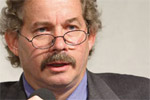Mongabay.com is partnering with the Skoll Foundation ahead of the Skoll World Forum on Social Entrepreneurship to bring a series of perspectives that aim to answer the question: how do we feed the world and still address the drivers of deforestation?
|
HOW DO WE FEED THE WORLD AND STILL ADDRESS THE DRIVERS OF DEFORESTATION? Soy, cattle, rice, palm oil, and logging are the principal drivers of deforestation. As global population increases from 7 billion to 9 billion by 2040, and as more and more people around the world rise out of poverty into the middle class, the demand for these commodities and practices will continue to rise with them. To address these issues, and in advance of the World Forests Summit hosted by the Economist in March, the Skoll World Forum on Social Entrepreneurship partnered with the Stanford Institute for the Environment and Mongabay News to surface the latest insights and innovations at the intersection of deforestation and sustainability. This debate will also set the stage for a larger discussion on deforestation at this year’s Skoll World Forum in Oxford, UK. |
In 1984, at the tail end of the Brazilian dictatorship, I took up residence in a frontier town called Paragominas in the eastern Amazon. I went to study rainforests and pasture restoration, but soon became captivated as well by the drama of the frontier itself. Forests were hotly contested among cattle ranchers, smallholder communities, land speculators and more than a hundred logging companies, sometimes with fatal results. If we are to meet rising global demand for food, conserve tropical forests, and mitigate climate change at the pace that is necessary, we must become much better at taming aggressive, lawless tropical forest frontiers where people are making a lot of money cutting forests down.
The last nine years of experience in trying to slow deforestation and support sustainable agriculture have demonstrated that single-mechanism strategies are, alone, insufficient. Instead, powerful synergies can be unleashed by linking together approaches that focus on policy innovation, market transformation, and direct support to farm sectors. Ultimately, success will be achieved when one tropical frontier after another makes the transition to a new type of rural development that is maintaining (or restoring) forests, increasing agricultural productivity, and raising the rural poor out of poverty. If there are widely perceived benefits from forest-friendly rural development—including greater market access, greater flows of finance, higher profits, higher tax revenues (to governments), improvements in rural livelihoods, and declines in rural violence—then political leaders, farmers, financial organizations, agribusinesses, commodity buyers, and retailers may gradually come to support the transition.
 Daniel Nepstad Executive Director & Senior Scientist, IPAM International Program Daniel Nepstad is Executive Director & Senior Scientist at IPAM International Program (Amazon Environmental Research Institute). He is co-founder of IPAM and Alianca da Terra, and is a forest and climate policy expert. |
We’re not quite there, yet. But the last nine years have been rich in lessons for how to move the forests and food agenda forward in a way that also helps to mitigate climate change. Paragominas is now a leader in sustainable rural development. Mato Grosso—Brazil’s agricultural giant located in the southeastern Amazon —has reduced deforestation more than any other state (90%) while continuing to expand beef and soy production. In Indonesia, Mexico, Peru, Colombia, Viet Nam, Nigeria, and many other nations, the potential for similar transitions is growing. Here is quick, incomplete synopsis of some key lessons:
Lesson 1. Learn what farmers need to make the transition.
Many farm sectors today have begun to make the transition to sustainability with few or no positive economic incentives and little technical assistance. Instead, many farmers in forest frontiers are vilified. They could become powerful proponents of a low-deforestation development model, but only if their needs and aspirations are understood and met.
“We must tame tropical forest frontiers, ending deforestation while increasing agricultural productivity and lifting the rural poor out of poverty.”
Lesson 2. Develop effective mechanisms for financing farmers’ transition
The biggest source of finance for the transition to low-deforestation development is often domestic banks, both public and private. Many of these institutions know they should be supporting the transition to sustainable farming, but are not sure how to go about it. Innovative finance mechanisms could favor farmers who are achieving simple metrics of sustainability, such as those developed by commodity roundtables.

Lesson 3. Build effective systems for supporting farmers technically
Good seeds, fertilizer, livestock breeding, land management techniques, water management, pest control, and commercialization strategies are all necessary components of farmers’ transition to low-deforestation production. Many of these ingredients of success are often missing.
Lesson 4. Agree on a single, simple definition of success in lowering deforestation across districts, counties, municípios, states, provinces and nations.
In Mato Grosso today, there are ten different processes underway to address deforestation, each with its own metric and language, and none of them providing positive incentives for foregoing deforestation. It is very difficult to address deforestation one farm, one mill, or one commodity at a time, especially in the absence of a clear definition of success. We need progress across entire jurisdictions, facilitating alignment with policies and law enforcement. We can start by defining progress against historical rates of deforestation (as jurisdictional REDD does).
Lesson 5. Commodity roundtables (RSPO, RTRS, Bonsucro), Consumer Goods Forum companies, and other firms must commit to buy preferentially from counties/states/nations that are lowing their deforestation and from farmers who are making the transition to sustainability.
Roundtables could add on jurisdiction-level reductions in deforestation to their principles and criteria; the CGF could also adopt incremental, jurisdiction-wide pathways to “zero net deforestation”.
Lesson 6. REDD programs must move beyond their current association with isolated projects to become an integral part of the rural development transition, fostering flows of benefits that reward jurisdictions that are slowing deforestation.
Few states or nations have begun to exercise the power of REDD as a policy framework for supporting the transition to low-deforestation, high-production rural development.
To discuss this commentary, please visit TAMING TROPICAL FOREST FRONTIERS
|
ALL POSTS IN THIS SERIES
Can we meet rising food demand and save forests? (04/03/2013) A few weeks ago the Skoll World Forum hosted an online debate on how increased global consumption can be balanced with sustainability. The debate asks how a rapidly growing world that is ever consuming can hope to feed everyone, and at the same time address the deforestation that is emitting massive amounts of carbon into the atmosphere and destroying the world’s greatest tropical forests. Many contributors made very strong points—even contradicting one another in their approaches and ideas. Strong ‘no deforestation’ commitments save forests and feed people (03/12/2013) As a global community, we have so far failed to answer this most pressing question; we have yet to build our cloud. Deforestation rates are down in some places, but overall, our forests continue to disappear much as they have for the past 50 years, driven principally by increasing global demand for food. Can we feed the world and save our forests? Yes, we can, and the solution lies in the global supply chain and the message some companies are now sending their suppliers: ‘If you cut down trees, I won’t buy your product.’ This has the power to silence bulldozers. It’s already doing so and now it’s time to go to scale. The need to jump-start REDD to save forests (03/08/2013) At least US$7.3 billion has been pledged for REDD+ over the period from 2008 to 2015, with $4.3 billion pledged for REDD+ readiness during the fast-start period alone (2010-2012). In addition to these funds, private investors, private foundations, and others have been channeling financial support to developing countries for REDD+ and related programs for several years now. A promising initiative to address deforestation in Brazil at the local level (03/05/2013) The history of the Brazilian Amazon has long been marked by deforestation and degradation. Until recently the situation has been considered out of control. Then, in 2004, the Brazilian government launched an ambitious program to combat deforestation. Public pressure—both national and international—was one of the reasons that motivated the government to act. Another reason was that in 2004, deforestation contributed to more than 55 percent of Brazil’s total greenhouse gas emissions, making Brazil the fourth-largest greenhouse gas emitter in the world. Saving forests by putting a price on them (03/04/2013) During the 2013 SuperBowl, the championship game of the US National Football League, a truck company aired an advertisement that likened farmers to God’s favorite assistant. It suggested that when God needs something tough, or gentle, done, he calls a farmer. The narration, taken from a speech given to the Future Farmers of America in 1978 by Paul Harvey, a radio host, plays directly to the near mythical stature of farmers and ranchers in American culture and their deep connection to nature. Saving forests by stemming agricultural sprawl (03/01/2013) I’m fortunate to travel the world helping conserve habitats for some of the world’s most iconic species. When I visit places like the Amazon and Sumatra, I’m still awestruck by their diversity and pristine beauty. I’m also reminded how threatened they are. Our growing demand for food and fiber is fueling deforestation in resource-rich regions of the world. As environmentalists, if we don’t change where and how we produce food and fiber, we can turn off the lights and go home. There won’t be any biodiversity left to protect. Can saving forests help feed the world? (02/28/2013) As world population climbs from 7 to a projected 9 billion people and emerging and developing economies demand ever more of the food and fiber that drive deforestation, many environmentalists ask with increasing urgency whether and how tropical forests can survive. But the question may actually be whether and how the world’s increasing, and increasingly rich, population can be fed unless tropical forests survive. The challenge of putting Brazil’s forests in good hands (02/28/2013) People often associate Brazil with its forests. It’s no wonder given that nearly 60% of the country’s territory is covered by forest and it holds about one-third of the world’s remaining tropical rainforests. You might assume that a country like this would care about educating people to sustainably manage this precious heritage. Well, you’d be wrong! The corporate conservation revolution (02/27/2013) There’s a new kind of environmental hero emerging. They don’t live in Washington, D.C., and they’re known more for their interest in increasing earnings than in reducing greenhouse gases. They are found in an unlikely place: The Corporate Boardroom, and they’re making a big difference in saving the worlds forests and our climate. In recent years, a group of visionary corporate leaders have been quietly teaming up with a growing number of environmental groups to take a hard look at what’s left of our planet’s natural resources. Together, they agree: we are past the point where our land and oceans can meet the food, energy and commodity demands of our planet’s seven billion inhabitants. |
Editor’s note: The opinions expressed in this op-ed do not necessarily reflect the views of Mongabay.com or its staff. Mongabay founder, president, and editor Rhett A. Butler served as an advisor to the Skoll Foundation from 2010-2012.
Related articles








